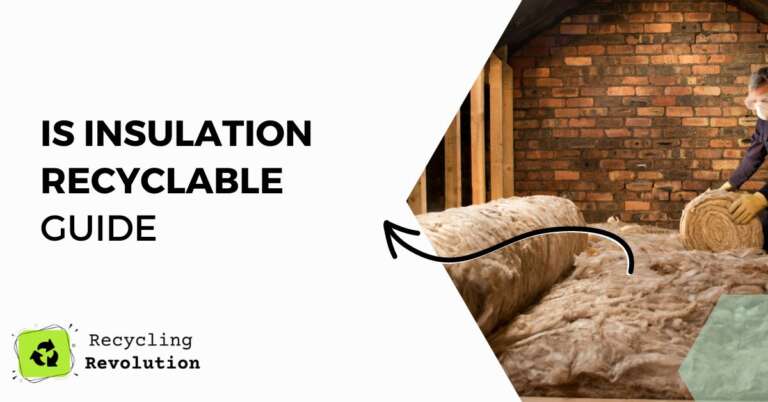In a world increasingly aware of our environmental impact, questions about the recyclability of commonplace materials are more prevalent than ever. One such question that I often come across as a professional in the industry is: How is insulation recyclable?
tl;dr: As an experienced researcher, I can assure you that insulation materials, particularly cellulose, fiberglass, and mineral wool, are indeed recyclable. The recycling process can conserve significant resources and reduce environmental harm. However, not all insulation is created equal, and the recyclability varies significantly based on material type. Let’s dive deeper into the specifics.
| Insulation Type | Is It Recyclable? |
|---|---|
| Cellulose | Yes |
| Fiberglass | Yes |
| Mineral Wool | Partially |
| Polystyrene (EPS and XPS) | Partially |
| Polyurethane and Polyisocyanurate | No |
| Spray Foam | No |
Understanding the Basics of Insulation Recycling
Insulation materials are a crucial component in our homes and workplaces, ensuring energy efficiency and comfort. However, they often end up in landfills at the end of their lifespan. It’s been estimated that insulation waste constitutes approximately 1.5% of total landfill waste, according to the Environmental Protection Agency (EPA). Here’s where the idea of insulation recycling comes into the picture.
I recommend understanding that the recyclability of insulation varies across types. Cellulose insulation, made primarily from recycled paper, is among the most eco-friendly and easily recyclable options. Fiberglass insulation is also recyclable, albeit with more energy-intensive processes. Mineral wool, on the other hand, can be challenging to recycle due to its complex composition.
The Recycling Process for Different Insulation Types
Let’s take a closer look at the recycling process for different insulation materials:
Cellulose Insulation
Cellulose insulation, primarily composed of recycled newspaper, is relatively easy to recycle. The process typically involves:
- Collection: Old cellulose insulation is collected from demolition or renovation sites.
- Sorting and Processing: The collected material is sorted and processed to remove contaminants.
- Reconstitution: The clean cellulose is then reconstituted into fresh insulation material.
Fiberglass Insulation
Fiberglass insulation recycling is a more complex process, requiring the glass fibers to be melted down and remanufactured. This process involves:
- Collection: Fiberglass insulation is gathered and transported to a recycling facility.
- Sorting: The insulation material is sorted to segregate the glass fibers.
- Melting and Re-manufacturing: The glass fibers are melted down and then re-manufactured into new insulation material.
As many experts have noted, the fiberglass recycling process is energy-intensive, but it’s worthwhile to consider its overall environmental benefits compared to the production of new fiberglass from raw materials.
Mineral Wool Insulation
Recycling mineral wool is tricky due to its composition of various minerals and synthetic materials. However, innovative methods have emerged to repurpose it into products like brick and cement.
Environmental Impact of Insulation Recycling
A useful suggestion would be to consider the environmental impact of insulation recycling. According to a study published in the Journal of Material Cycles and Waste Management, recycling insulation materials can result in a reduction of CO2 emissions by up to 3.7 tons for every ton of insulation recycled.
Moreover, insulation recycling helps conserve significant resources by reducing the need for new raw materials.
Commonly Overlooked Tips About Insulation Recycling
When thinking about insulation recycling, here are some tips often overlooked:
- Selection: Opt for easily recyclable insulation types, such as cellulose and fiberglass.
- Disposal: Never simply throw away old insulation. Look for local recycling programs or facilities.
- Innovation: Keep an eye out for emerging insulation recycling technologies and practices.
The Challenges of Insulation Recycling
While the benefits of recycling insulation are clear, there are several challenges that need to be addressed. The cost of recycling can sometimes outweigh that of new production, especially for materials like fiberglass that require energy-intensive processes. There’s also a lack of recycling facilities capable of handling insulation in many regions, making proper disposal difficult.
Logistical challenges such as the collection and transportation of waste insulation can further complicate recycling efforts. Addressing these issues is crucial for enhancing the viability of insulation recycling.
Highlighting Insulation Recycling Programs and Initiatives
A growing number of programs and initiatives, both governmental and private, are promoting insulation recycling. For instance, the Construction & Demolition Recycling Association (CDRA) encourages the responsible disposal of waste from construction and demolition, including insulation.
Moreover, various manufacturers have started take-back programs, offering to recycle their products once they reach the end of their lifespan. I recommend readers to research such initiatives in their local area to contribute to these efforts.
Future Directions
Innovation is key to overcoming the challenges and maximizing the benefits of insulation recycling. Emerging technologies promise more efficient recycling processes, reducing the associated costs and environmental impact. For example, advances in mechanical and chemical recycling techniques may offer new ways to recycle materials like mineral wool that are currently difficult to recycle.
Furthermore, research is underway to develop new insulation materials that are easier to recycle. By choosing these innovative materials, consumers can play a part in promoting insulation recycling.
Conclusion
The recyclability of insulation presents a significant opportunity toreduce environmental harm and conserve resources. While challenges exist, particularly regarding energy-intensive recycling processes and the recyclability of certain types of insulation, ongoing advancements in recycling technology promise a more sustainable future.
The key is to make informed decisions when choosing and disposing of insulation materials. Opt for those that are recyclable and have recycling programs available in your area. Every choice made towards sustainability, however small, contributes to the broader environmental cause.
FAQs
Is all insulation recyclable?
Not all insulation is recyclable. The recyclability largely depends on the material. Cellulose and fiberglass are commonly recycled, while mineral wool is more challenging to recycle.
How is fiberglass insulation recycled?
Fiberglass insulation recycling involves collection, sorting, and then melting down and remanufacturing the glass fibers. The process is energy-intensive but still offers environmental benefits compared to new production.
What is the environmental impact of insulation recycling?
Insulation recycling can significantly reduce environmental harm. It has been found to result in a reduction of CO2 emissions by up to 3.7 tons for every ton of insulation recycled. Additionally, it helps conserve resources by reducing the need for new raw materials.
Are there any tips for recycling insulation?
Always select insulation types that are easily recyclable and dispose of old insulation through proper channels. Keep an eye out for advancements in recycling technologies and practices.

